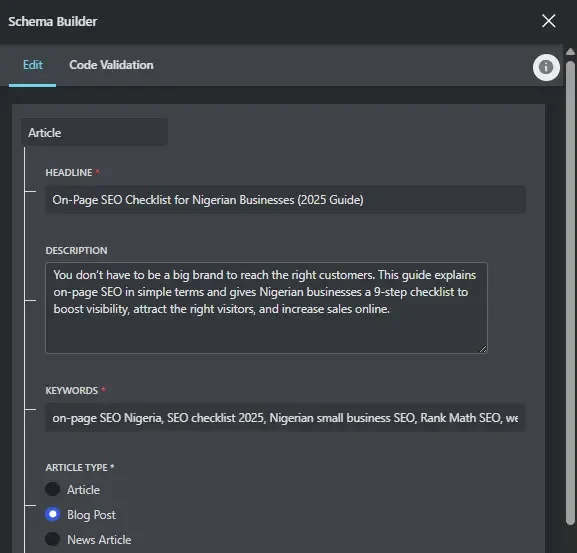On-Page SEO Checklist for Nigerian Businesses
You don’t have to be a big business owner to reach the right people for your business. This on-page SEO checklist help you improve visibility, boost web traffic, and increase conversions.
Septenber 29th, 2025.

If you have created a website for your business, you are just about getting started. On-page SEO is essential for your business after creating a website. In this article, we’ll explain on-page SEO. We’ll share a checklist. It will help you improve visibility, boost web traffic, and increase conversions.
What is On-Page SEO? Breaking Down On-Page SEO in Simple Terms
On-page SEO is the process of optimizing every element within your website so search engines and users can easily understand and engage with your content. For Nigerian businesses, this means focusing on local keyword research, crafting clear title tags and meta descriptions, creating mobile-friendly, fast-loading pages, using Schema markup for local visibility, and ensuring your URLs, headers, and images all work together to improve rankings.
Why this On-Page SEO Checklist for Nigerian Businesses is crucial in 2025
- Enjoy Cost-Effective, Long-Term Marketing: Unlike paid ads that stop driving traffic when your budget runs out, on-page SEO is a one-time investment with lasting returns. Properly optimized pages can keep generating leads and sales for months even years without additional spending.
- Build Credibility and Trust: In today’s digital marketplace, trust is everything. Before customers buy from you, they need to feel confident in your business. A well-optimized website with clear product descriptions, mobile-friendly pages, and compelling visuals shows that you’re professional, reliable, and ready to serve.
Expand Local Reach & Visibility: This helps you control how your business shows up in Google Search and Google Maps. you can optimize your products and services for the exact areas you serve. For example, if you run a cleaning service in Lagos, optimize your profile for keywords like:
- “Cleaning service near me”
- “Cleaning service in Ikoyi”
- “Office cleaning in Victoria Island.”
This way, when people in those areas search on Google, your business appears.
Deliver a Better User Experience: Fast-loading pages, clear navigation menus, and mobile responsiveness keep visitors engaged and encourage them to stay longer. A smooth user experience reduces bounce rates and increases the chance they’ll convert into paying customers.
9-Steps On-Page SEO Checklist for Nigerian Businesses
Step 1 – Keyword Research
Keyword research is the foundation of SEO. They are the words and phrases people use in Google to search for products, services, or information. If you target the wrong keywords, your website won’t show up when your ideal customers are searching.
Use Keyword Tools
SEMrush, Ahrefs, Wordstream, Moz, Google Keyword Planner. And check how people in Nigeria are searching. After having a list of keywords, select the ones that relate to your business. These become your primary keywords. Let’s say we selected “cleaning service for kitchens” from the list of keywords generated. Let’s see how we can structure it as part of the service pages on your website.

Note that I have published a blog post that explains in detail how you can perform keyword research for free.
Click here to read more.
Step 2 – Optimize Your Page Structure
Your website’s structure tells Google what each page is about. If your pages aren’t optimized, even the best content won’t rank. Here’s what to focus on:
Page Titles (Title Tags)
- Include your primary keyword in the page title of your web pages and make it natural and click-worthy.
- Keep it under 60 characters.
Example (Affordable deep cleaning service for kitchens in Ikoyi). Where the primary keyword is “cleaning service for kitchens.”
Meta Descriptions
- Add a modifier plus your primary keyword, and a call to action.
- Keep it under 160 characters.
Example: “Discover affordable cleaning services for kitchens in Ikoyi. Book John’s Cleaning service for homes, offices, events in Lagos.”
URL Structure
Keep URLs short, clean, and keyword-rich.
- Bad:
- Good:

Headings (H1, H2, H3)
- Each page should have only one H1 (which is the main title with the keyword).
- Use H2s and H3s to break content into sections, sprinkling in secondary keywords.
Example: On the Service Page:
H1 can be, “Deep Kitchen Cleaning Service in Ikoyi.”
H2: What is Included in Our Deep Cleaning Process
H2: Contact us
Internal Linking
- Link between your pages using relevant keywords.
Example:
Link Contact us on your service page to your contact page.
Write a blog post on “Safe and Eco-Friendly Cleaning Supplies for Your Kitchen.” Then, link to your service page.
Spontaneous and natural use of keywords.
- Use keywords naturally in sentences and avoid keyword stuffing.
Step 3 – Image and Media Optimization
Search engines can’t “see” images the way humans do; they rely on your file names, alt text, and context. Optimizing your images and media improves your SEO.
Use descriptive file names and alternative (alt) text: Always rename your files (images, videos, etc.) to include the primary keyword.
- Bad: IMG_456.jpg
- Good: deep-kitchen-cleaning-ikoyi.webp
Compress images for speed: Compressing images before uploading them to your website. It reduces your image size and helps your site load images faster. Tools: TinyPNG, Squoosh, Cloudinary.
Use modern formats (WebP/AVIF): WebP and AVIF are newer formats for saving files that offer:
- Smaller file sizes (faster loading times).
- High-quality visuals
Video Optimization
- Save in MP4, WebM formats for smaller sizes.
Step 4 – Internal & External Linking
Use a clear internal linking strategy: Make sure to develop your contents in a way that it links to another page. On no occasion should a page stand on its own. Expand relevant topics around your business/industry in a broader context. This can create opportunities for inter-linking. You can make use of “READ MORE” as a signal to link to other web pages.
Fix broken links: Check for web pages that show a ‘page not found’ error. If this error occurs on a page linking to your website, update or redirect the link to a relevant page on your site. To avoid losing traffic and SEO value.
- A “page not found” can be redirected to your Home Page.
Use external links to authoritative sources: Ensure the sources you link to outside of your website have a high domain authority score. This improves your site’s relevance. Google sees that you’re connecting your content to established, related topics. Use Ahrefs domain authority checker to find out.
Step 5 – Schema Markup & Structured Data
Schema markup is code you add to your website to help search engines understand your content better. It also improves the way your site appears in search results.
Add Relevant Schema Types:
- Article Schema – For blog posts and articles.
- FAQ Schema – For frequently asked questions, so they can appear directly in search results.
- Local Business Schema – For location-based businesses (e.g., cleaning services in Lagos) to boost visibility in local searches.
Optimize for Rich Snippets & AI Overviews: Schema helps Google show rich snippets (like star ratings, FAQs, business info, product details) and improves your chances of appearing in AI overviews.

Step 6 – Improved User-Experience
A user-friendly website makes it easy for visitors to find what they need while ensuring smooth performance. Two key areas to focus on are navigation and page speed.
Ensure intuitive navigation for users:
Your website should be easy to move around. Visitors should find what they’re looking for without confusion.
- Clear CTAs (Calls-to-Action): Make sure buttons and links say exactly what they do. (e.g., “Book a Cleaning” instead of “Click Here”). Avoid misleading or vague wording.
- Logical Linking: Structure your pages in a way that makes sense. For example, your “Services” page should link to each individual service page, and your “Contact” page should be easy to reach from anywhere on the site.
- Consistent Menus: Use simple, consistent navigation menus across all pages so users never feel lost
- Page Speed Testing Tools (e.g., Google PageSpeed Insights, GTMetrix, Pingdom)
Use any of these tools to check how quickly your website loads and get a detailed report on what’s slowing it down.

Major issues that commonly cause slow website load times include:
- Uncompressed images: Always compress or convert images to lighter formats (WebP, AVIF).
- Too many plugins or scripts: Remove unused plugins, reduce heavy JavaScript, and optimize CSS.
- No caching: Enable browser and server-side caching so repeat visitors load your site faster.
- Large files: Minify CSS, HTML, and JavaScript to reduce file sizes.
- Slow hosting/server response time: Upgrade your hosting plan or use a Content Delivery Network (CDN).
Step 7 – Use the Right SEO Plugins / Tools
The right tools can save you time and make your SEO strategy more effective. Rank Math and Yoast SEO are great tools for WordPress users. They help you optimize titles, meta descriptions, and on-page SEO elements.
Step 8 – Index Your Web Pages
- The step in SEO is making sure Google can actually find your site. To do this, you need to submit your XML sitemap to Google Search Console. An XML sitemap is a file that lists all the important pages of your website. Submitting it helps Google’s “spiders” (the bots that crawl the web) find your pages. This way, they get indexed faster. Without indexing, your pages will never show up in search results, no matter how good your content is.
For a cleaning service in Lagos with pages like Home, Services, and Contact, submit your sitemap. This helps Google find your pages and start ranking them.

- Set up Google Analytics: After indexing your web pages, set up Google Analytics. This helps you track your site visitors and know which web pages perform well.
Step 9 – Track & Measure Success
SEO is never “set it and forget it.” After your site is indexed and optimized, you need to track, analyze, and improve continuously:
- Check Google Search Console weekly for indexing issues, crawl errors, and keyword performance.
- Review Google Analytics 4 (GA4) data to see which pages drive the most traffic, conversions, and engagement.
- Track keyword rankings using tools like Ahrefs, SEMrush, or Ubersuggest to monitor visibility.
- Audit backlinks regularly to maintain quality and disavow spammy ones.
- Re-optimize old content – update keywords, add fresh info, and improve readability to maintain rankings.
- Submit updated pages to Google for re-indexing whenever you make major changes.
- Stay updated with SEO trends (Google algorithm updates, AI search, local SEO shifts, etc.).
Key Takeaways
- On-page SEO is the backbone of ranking on Google.
- Small actions like optimizing headings, compressing images, and using schema can make a big difference.
- Why Consistent On-Page SEO Wins in Nigeria: Nigeria has a fast-growing digital economy, and competition online is increasing daily. Consistently applying on-page SEO ensures your business is visible in search results, builds trust with local customers, and drives more sales without relying only on ads.
